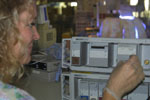Blood testing improved for patients, clinicians
by Samuel Horton, M.D.Emerald Communications and Training Committee
Beginning in February of 2001, MUSC embarked on a project to bring blood gas testing to the point of care, the patient’s bedside. This goal, part of a collaborative effort between the departments of Pathology and Laboratory Medicine and Pediatrics, is being accomplished via the use of a small, handheld device manufactured by i-STAT.


 Joyce
Foster, the lab’s i-STAT project coordinator, left photo, shows the small
size of an analysis cartridge. In center photo NNICU nurse Leslie Schall,
R.N., puts a drop of the patient’s blood into the glucose cartridge and
in final photo Schall inserts the glucose cartridge into the i-STAT module
for immediate bedside display, electronic communication to the Cerner lab
system and the Oacis clinical data repository.
Joyce
Foster, the lab’s i-STAT project coordinator, left photo, shows the small
size of an analysis cartridge. In center photo NNICU nurse Leslie Schall,
R.N., puts a drop of the patient’s blood into the glucose cartridge and
in final photo Schall inserts the glucose cartridge into the i-STAT module
for immediate bedside display, electronic communication to the Cerner lab
system and the Oacis clinical data repository.
The i-STAT device, currently used in thousands of institutions in the United States and around the world, is a revolutionary bedside solution for rapid (“stat”) blood testing that offers many critical tests needed by clinicians.
The system requires the caregiver to fill a single-use disposable cartridge with 2-3 drops of blood. The cartridge is then inserted into either a portable analyzer or a nearby blood analysis module. Results are displayed in approximately two minutes on the analyzer display and a bedside patient monitor. The results are immediately electronically transferred to the central laboratory system (Cerner), which in turn sends them on to MUSC’s main clinical data repository (Oacis). Clinicians can see these results in their patient rosters in the Oacis Clinical Display either integrated into the list of all lab results or segregated into a separate column (labeled POCT - Point-Of-Care Testing) that lists just i-STAT results.
Point-of-care testing allows caregivers to get faster test results and, therefore, make immediate treatment decisions at the patient’s bedside thus improving overall patient care. The small amount of blood required for i-STAT testing leads to other benefits, too. Many people are surprised to learn that ordinary blood draws for lab tests happen often enough in some hospitalized patients to actually cause anemia. Sometimes patients, especially critically ill neonates, even need transfusions because of all the blood that’s drawn for lab testing. i-STAT testing can significantly reduce the incidence of anemia and the need for subsequent transfusion therapy.
The system is currently being used for selected groups (“panels”) of
common lab tests in the neonatal and pediatric intensive care units. Periodic
interdisciplinary meetings are conducted to provide feedback on how the
system is working so that appropriate adjustments can be made to best meet
the clinical needs. The ultimate success of the program will be measured
by its ability to improve patient care and outcomes.